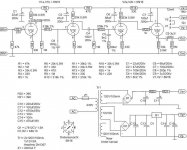There are a wide range from different kinds of RIAA equalizer networks. I am looking not for such networks with the use of coils - only caps and resistors - go to
https://www.google.de/search?q=riaa...Cqf_ygPzsIEI&ved=0CAcQ_AUoAQ&biw=1280&bih=857
for finding most of all the exist versions.
From the last there are two basically kinds:
1) RIAA preamp with passive network between two line amps
2) RIAA preamp with NFB RIAA network and one oprerational OP-Amp as IC or as discrete solution
But there are a wide range of mixtures from both of them (actually two passive 6db low pass filter with different cut-off frequencies) - most with two independent gain stages.
I want to have a list with short form explanation regarded the pros and cons of all often used topologies.
Where I can find this online or in a suited amplifier book?
I am looking to those topology with best sound, and not with lowest possible noise, because the residual noise from the records is still present (in opposite by a use of microphone at similar preamps).
This URLs are of interest:
http://www.tubecad.com/2007/09/blog0120.htm
http://www.tubecad.com/articles_2002/RIAA_Preamps_Part_1/RIAA_Preamps_Part_1.pdf
http://www.tubecad.com/articles_2002/RIAA_Preamps_Part_2/RIAA_Preamps_Part_2.pdf
but without pros and cons.
Thank you very much for advices.
https://www.google.de/search?q=riaa...Cqf_ygPzsIEI&ved=0CAcQ_AUoAQ&biw=1280&bih=857
for finding most of all the exist versions.
From the last there are two basically kinds:
1) RIAA preamp with passive network between two line amps
2) RIAA preamp with NFB RIAA network and one oprerational OP-Amp as IC or as discrete solution
But there are a wide range of mixtures from both of them (actually two passive 6db low pass filter with different cut-off frequencies) - most with two independent gain stages.
I want to have a list with short form explanation regarded the pros and cons of all often used topologies.
Where I can find this online or in a suited amplifier book?
I am looking to those topology with best sound, and not with lowest possible noise, because the residual noise from the records is still present (in opposite by a use of microphone at similar preamps).
This URLs are of interest:
http://www.tubecad.com/2007/09/blog0120.htm
http://www.tubecad.com/articles_2002/RIAA_Preamps_Part_1/RIAA_Preamps_Part_1.pdf
http://www.tubecad.com/articles_2002/RIAA_Preamps_Part_2/RIAA_Preamps_Part_2.pdf
but without pros and cons.
Thank you very much for advices.
Last edited:
Danyuk and Pilko did an investigation into various circuit topologies you might find useful.
http://www.angelfire.com/az3/dimitri/images/riaa.pdf
http://www.angelfire.com/az3/dimitri/images/riaa.pdf
Hmmm sure looks like a Large pile 'o parts.
What ever happened to the Simple Few/minimal parts designs?
From my small experiences the rate of diminishing returns in Vinyl playback hits Early and Hard.
With Many of the exotic claims in:
TT's, Carts and Phono stages being Very difficult to hear.
Daresay even bordering on illusory... in some cases
Yesss...I know it's a hobby .
What ever happened to the Simple Few/minimal parts designs?
From my small experiences the rate of diminishing returns in Vinyl playback hits Early and Hard.
With Many of the exotic claims in:
TT's, Carts and Phono stages being Very difficult to hear.
Daresay even bordering on illusory... in some cases
Yesss...I know it's a hobby .
To make life easier, opamps, passive networks and MM carts, you can make life a bit easier if you derive some of the T5 compensation from the loading resistor and the self-inductance of the cartridge. (The issue with opamps is that they run out of gain on peak material above a few kHz where the cartridge output can exceed 8mV.) Bob Cordell did a great job explaining in his VinylTrak phono pre in Linear Audio Volume 4.
- Status
- This old topic is closed. If you want to reopen this topic, contact a moderator using the "Report Post" button.
- Home
- Source & Line
- Analogue Source
- Pros and cons of various RIAA Network topologies
